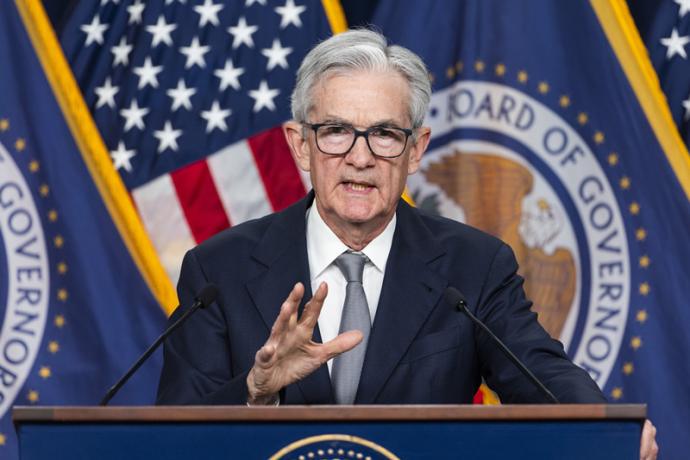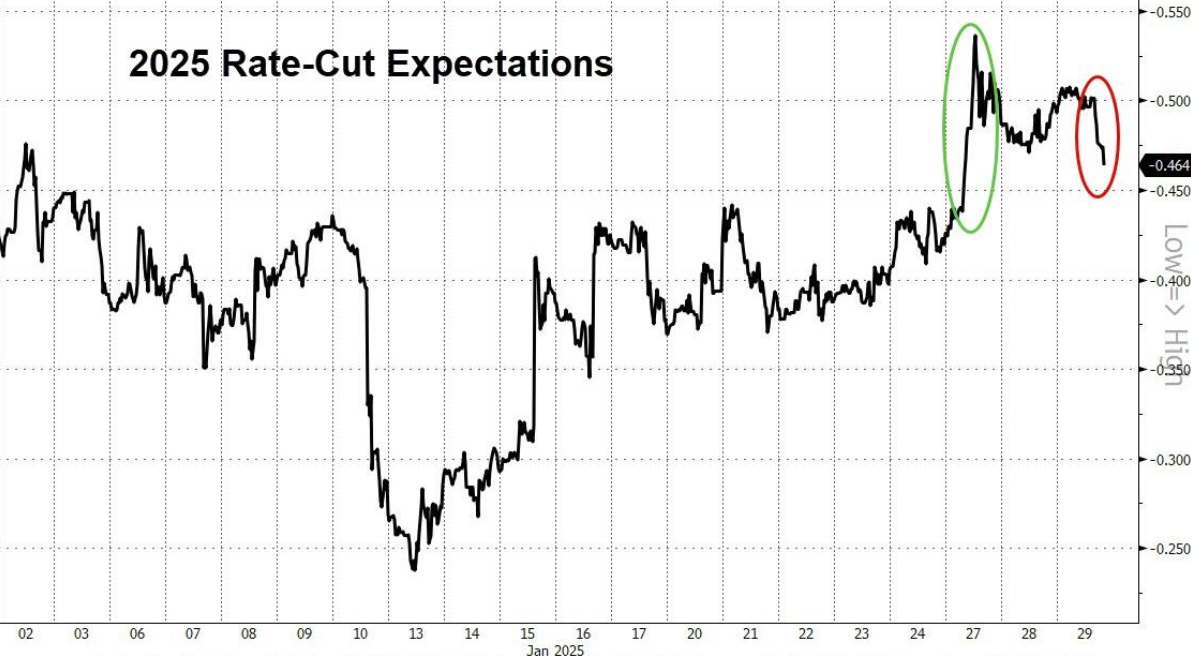
Original: Jinshi Data
Despite pressure from new U.S. President Donald Trump a few days ago on policymakers to immediately lower interest rates, the Federal Reserve decided to keep interest rates unchanged this week, with Fed Chairman Jerome Powell making it clear that there is no rush to adjust interest rates.
Just after Powell's press conference, Trump criticized the Fed again. He wrote on Truth Social:
"Because Powell and the Fed have failed to stop the inflation problem they created, I will do it by unleashing American energy production, cutting regulations, rebalancing international trade, and revitalizing American manufacturing."
“If the Fed spent less time on DEI (diversity, equity, and inclusion), gender ideology, ‘green’ energy, and fake climate change, inflation would never be a problem.”
He did not comment directly on interest rates or Wednesday's decision. Trump has made a habit of publicly expressing his views on monetary policy since his first term. In order to maintain the Fed's autonomy from political influence, successive U.S. presidents have avoided publicly expressing their views on monetary policy.
In a statement after the meeting, officials reiterated that inflation remains "a bit elevated" but removed references to progress toward the 2% inflation target. Powell said the change was not intended to send a policy signal. Fed policymakers also updated their description of the labor market, replacing the previous term "somewhat moderate" with "strong."
Powell said at a news conference following the release of the statement that recent inflation data looked "good," but "we're not going to read too much into two good or two bad (inflation) numbers."
Earlier Wednesday, before Trump posted, he told reporters he would not comment on "anything the president said about interest rates ." "The public should have confidence that we will continue to do our job as usual."
Powell said he had not had any direct contact with Trump. “There is a lot of research that shows (independence) is the best way for a central bank to operate,” he added.
The Fed is now in wait-and-see mode, with officials waiting for more inflation and employment data and clarity on the impact of Trump's policies. Market expectations for the Fed's rate cuts in 2025 are declining. According to CME's "Fed Watch", the probability of the Fed keeping interest rates unchanged in March is 82%.

Institutional interpretation
George Cipolloni, portfolio manager at Penn Mutual Asset Management:
“The latest policy statement was initially interpreted as more hawkish than expected. They’re going to wait a while and see what happens with inflation, which is probably not the worst idea in the world because they don’t want to overshoot policy. I think they overshot a bit last year by cutting rates by 100 basis points.
“So the Fed’s policy outlook is intertwined with the inflation outlook, and now we have to marry that with a new administration and its new policies, some of which do look a little inflationary, or at least potentially so. So it makes sense for the Fed to be patient on that front. I don’t think Trump is going to like the Fed’s response and the Fed’s tone. But it feels like the right thing to do at this point.”
Rusty Vanneman, chief investment strategist at Orion:
“The Fed made the right decision by keeping rates steady. Inflation remains a concern, while the economy is holding up. They are remaining cautious, which makes sense. For now, this provides some stability for investors as we closely watch for any future changes. As always, we are focused on the long term.”
Michael Rosen, chief investment officer of Los Angeles Investment Company:
“The bond market sold off after the FOMC statement was released because it did not mention that inflation was moving toward the 2% target. It is surprising that investors were surprised by this obvious fact. Inflation has been sticky for the past 18 months, that is, it has not fallen further to 2%. The market has wrongly expected the Fed to ease monetary policy significantly for the past two years. Investors should continue to short bonds. ”
Ellen Hazen, chief market strategist at FLPutnam Investment Management:
"The market was absolutely right. If you look at the fed funds futures, they were barely budging. So I think the market correctly realized that the impact of this meeting was neutral. The change in the Fed's rhetoric was a little bit more hawkish -- they no longer talk about a moderation in the labor market, they say it's staying stable. They no longer talk about inflation slowing, they say it's staying elevated. So those two things are slightly more hawkish ."
“It’s very tricky to move to a less data-dependent process when the Fed is potentially at odds with the administration. Now is not the time to make that shift. While I do think they are hinting at it, they can’t say it publicly.”
Brian Jacobsen, economist at Annex Wealth Management:
“The Fed seems to think the economy is stuck in a dilemma of low unemployment and high inflation. The statement could be interpreted as mildly hawkish , suggesting that a little move in rates could tip the economy out of that equilibrium.
Matthias Scheiber, head of multi-asset solutions team at Allspring Global Investments:
"We think the window for any future rate cuts may not open before May , and we expect the Fed to cut rates twice this year."
“As the new administration begins to implement its fiscal policy plans, we expect the Fed to remain cautious in monitoring inflation. For 2025, interest rate markets currently expect the Fed to cut rates to around 4% by the end of the year. Much will depend on how the impact of US fiscal policy on inflation pans out.”
“We continue to favor equities , especially cheaper stocks, as well as those in international markets that benefit from central bank rate cuts and currency depreciation. We expect equity gains to extend and believe any further easing of accommodative monetary policy is likely to support equity prices in the medium term. Despite the narrowing of spreads, the outlook for high-yield bonds remains positive as the likelihood of a US recession appears unlikely.”
Michele Raneri, TransUnion’s head of U.S. research and consulting:
“Following a series of stronger-than-expected economic indicators, the Federal Reserve today abandoned its decision to cut interest rates again, opting instead to keep them unchanged for now. This was the first FOMC meeting since July 2024 without a rate cut. It remains to be seen how many rate cuts there will be in 2025. While inflation concerns have eased significantly, they still exist. Therefore, there is a good chance that there will be fewer rate cuts next year than expected just a few months ago. We will continue to monitor how previous rate cuts play out in the economic ecosystem.”
Michael Brown, senior research strategist at Pepperstone:
“To be honest, I’m not sure that (the Fed’s removal of references to inflation ‘progress’ in its policy statement) is a game changer, although it may indicate that policymakers want to see further progress against inflation before cutting rates again later this year. Still, the path of future rates is definitely down . Given that the Fed is starting this year almost exactly where they left off in 2024, the timing of any rate cuts remains dependent on future data releases.”
Lindsay Rosner, head of multi-sector investing at Goldman Sachs Asset Management:
“The new year has seen the Fed enter a ‘new phase’ of its easing cycle, with strong economic growth and resilient employment data providing room for a more patient approach amid rising data and policy uncertainty. While we still believe the Fed’s easing cycle is not over, the FOMC would like to see further progress in inflation data to achieve the next rate cut as they removed the reference to inflation progress being made.”
Joseph Sroka, chief investment officer at Novapoint:
"The Fed kept interest rates unchanged as expected. It made it clear as early as December that the pace of rate cuts would slow in 2025. With the new administration taking office and its fiscal and other policies proposed, the Fed is now in a good position after cutting interest rates by 100 basis points to deal with the complex data changes caused by the first three or four months of the new administration."
Jamie Cox, managing partner of Richmond consulting firm Harris Financial Group:
“ The Fed just told us there would be no rate cuts in March, so all eyes are on May . Removing the language about inflation progress has led some market participants to conclude that the Fed is shifting its rate bias from lower to higher – a view I disagree with. I believe the Fed removed this language in an effort to get the market to focus not on the trajectory of inflation, but on economic growth and unemployment, both of which are in very good positions.”
Mark Luschini, chief investment strategist at Janney Montgomery Scott:
“The fact that rates remained unchanged is not surprising. However, the removal of the inflation progress language suggests that the Fed acknowledges that inflation remains above the Fed’s target and may be stabilizing above the target rate .”
Guy Lebas, chief fixed income strategist at Janney Montgomery Scott:
“After a cumulative 100 basis points of rate cuts, the Fed has slowed the pace of rate cuts. While the direction of travel is still toward rate cuts, the pace of that travel has slowed. Continued strong economic growth and some slightly higher inflation data in the fourth quarter are the culprits. For now, the slower pace of rate cuts means a “skipped” rate cut at the January FOMC meeting, and then perhaps another rate cut in March as first quarter inflation data approaches 2%. This is far from certain and depends on hard-to-predict near-term data, but a rate cut in March is the most likely outcome in our view.”











